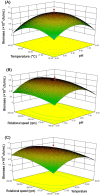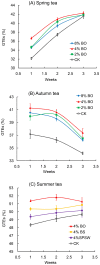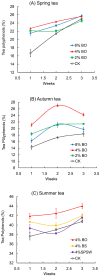Bioconversion of wastewater from sweet potato starch production to Paenibacillus polymyxa biofertilizer for tea plants
- PMID: 24576979
- PMCID: PMC3937799
- DOI: 10.1038/srep04131
Bioconversion of wastewater from sweet potato starch production to Paenibacillus polymyxa biofertilizer for tea plants
Abstract
Wastewater from the sweet potato starch industry is a large source of nutrient-rich substrates. We assessed whether this wastewater could be used to produce Paenibacillus polymyxa biofertilizer for foliar application to tea trees. Using the central composite design methods we experientially determined that the optimal culture conditions for P. polymyxa were pH, 6.5; temperature, 29.0 °C; and incubation time, 16 h. Under these conditions, a maximum biomass of 9.7 × 10(9) cfu/mL was achieved. We then conducted a yearlong field investigation to determine the effect of P. polymyxa biofertilizer on the growth of tea plants (Camellia sinensis). Tea yield, quantity of water extract, and tea polyphenol levels were significantly higher after foliar application of the biofertilizer compared to that in the controls by an average of 16.7%, 6.3%, and 10.4%, respectively. This approach appears to be technically feasible for organic tea production, and is an environmentally friendly way to utilize wastewater.
Figures




References
-
- Wang R., Wang Y., Ma G., He Y. & Zhao Y. Efficiency of porous burnt-coke carrier on treatment of potato starch wastewater with an anaerobic–aerobic bioreactor. Chem. Eng. J. 148, 35–40 (2009).
-
- Chavalparit O. & Ongwandee M. Clean technology for the tapioca starch industry in Thailand. J. Cleaner Prod. 17, 105–110 (2009).
-
- Jin B., van Leeuwen H. J., Patel B. & Yu Q. Utilisation of starch processing wastewater for production of microbial biomass protein and fungal α-amylase by Aspergillus oryzae. Bioresour. Technol. 66, 201–206 (1998).
-
- Verma M., Brar S. K., Tyagi R. D., Surampalli R. Y. & Valéro J. R. Starch industry wastewater as a substrate for antagonist, Trichoderma viride production. Bioresour. Technol. 98, 2154–2162 (2007). - PubMed
-
- Xue F. et al. Pilot-scale production of microbial lipid using starch wastewater as raw material. Bioresour. Technol. 101, 6092–6095 (2010). - PubMed
Publication types
MeSH terms
Substances
LinkOut - more resources
Full Text Sources
Other Literature Sources
Molecular Biology Databases

